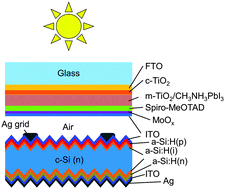Organic–inorganic halide perovskite/crystalline silicon four-terminal tandem solar cells†
Abstract
Tandem solar cells constructed from a crystalline silicon (c-Si) bottom cell and a low-cost top cell offer a promising way to ensure long-term price reductions of photovoltaic modules. We present a four-terminal tandem solar cell consisting of a methyl ammonium lead triiodide (CH3NH3PbI3) top cell and a c-Si heterojunction bottom cell. The CH3NH3PbI3 top cell exhibits broad-band transparency owing to its design free of metallic components and yields a transmittance of >55% in the near-infrared spectral region. This allows the generation of a short-circuit current density of 13.7 mA cm−2 in the bottom cell. The four-terminal tandem solar cell yields an efficiency of 13.4% (top cell: 6.2%, bottom cell: 7.2%), which is a gain of 1.8%abs with respect to the reference single-junction CH3NH3PbI3 solar cell with metal back contact. We employ the four-terminal tandem solar cell for a detailed investigation of the optical losses and to derive guidelines for further efficiency improvements. Based on a power loss analysis, we estimate that tandem efficiencies of ∼28% are attainable using an optically optimized system based on current technology, whereas a fully optimized, ultimate device with matched current could yield up to 31.6%.


 Please wait while we load your content...
Please wait while we load your content...